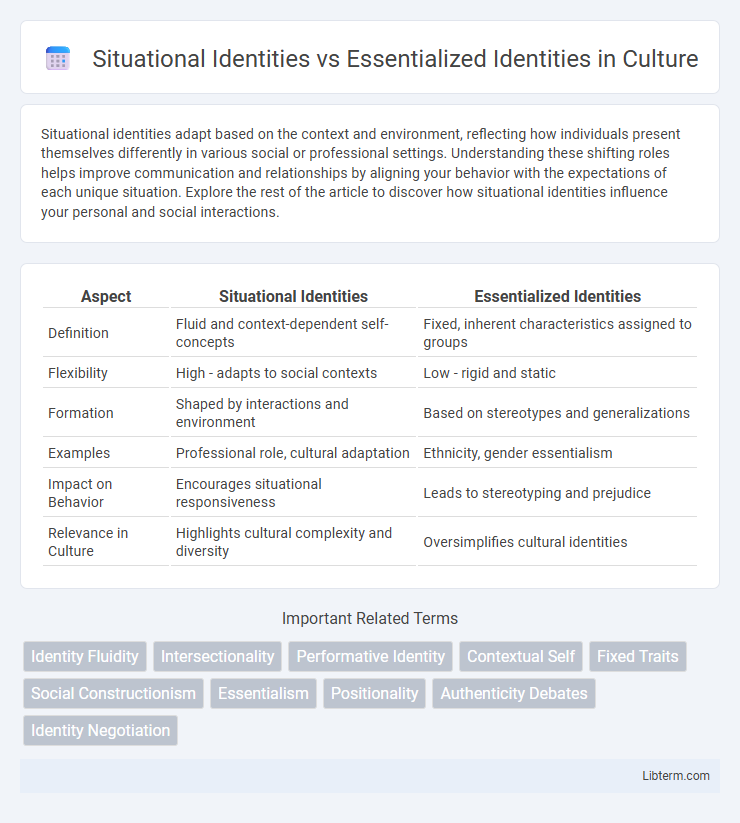Situational identities adapt based on the context and environment, reflecting how individuals present themselves differently in various social or professional settings. Understanding these shifting roles helps improve communication and relationships by aligning your behavior with the expectations of each unique situation. Explore the rest of the article to discover how situational identities influence your personal and social interactions.
Table of Comparison
| Aspect | Situational Identities | Essentialized Identities |
|---|---|---|
| Definition | Fluid and context-dependent self-concepts | Fixed, inherent characteristics assigned to groups |
| Flexibility | High - adapts to social contexts | Low - rigid and static |
| Formation | Shaped by interactions and environment | Based on stereotypes and generalizations |
| Examples | Professional role, cultural adaptation | Ethnicity, gender essentialism |
| Impact on Behavior | Encourages situational responsiveness | Leads to stereotyping and prejudice |
| Relevance in Culture | Highlights cultural complexity and diversity | Oversimplifies cultural identities |
Understanding the Concept of Identity
Situational identities refer to the fluid and context-dependent aspects of identity that shift according to social settings, roles, or interactions, highlighting adaptability and social dynamics. Essentialized identities are perceived as fixed, inherent characteristics rooted in biology, culture, or tradition, often leading to rigid categorization and stereotyping. Understanding identity involves recognizing the interplay between these situational and essentialized dimensions, acknowledging both the stability of core traits and the variability shaped by environments and experiences.
Defining Situational Identities
Situational identities refer to the fluid and context-dependent aspects of self that individuals adopt based on social settings, roles, or interactions, contrasting with essentialized identities which are perceived as fixed and inherent traits. These identities emerge dynamically, influenced by factors such as location, audience, and cultural expectations, allowing for adaptability and multiple self-presentations. Understanding situational identities is crucial for analyzing social behavior, communication strategies, and identity negotiation in diverse environments.
Exploring Essentialized Identities
Essentialized identities refer to fixed, inherent characteristics attributed to individuals or groups, often simplifying complex social realities into static categories. These identities are frequently reinforced by stereotypes, cultural myths, or institutional frameworks, limiting personal expression and social fluidity. Exploring essentialized identities involves critically examining how such rigid labels impact perceptions, interactions, and power dynamics within diverse social contexts.
Historical Contexts of Identity Formation
Situational identities emerge fluidly based on historical contexts, reflecting the dynamic interplay between individuals and social environments during periods of political upheaval, colonization, or migration. Essentialized identities are often constructed or imposed to create fixed categories that serve nationalist or colonial agendas, solidifying group boundaries in response to historical power struggles. Understanding these identity formations requires analyzing specific episodes such as the African diaspora, post-colonial nation-building, and civil rights movements where identity was strategically navigated and contested.
Social Influences on Situational Identities
Situational identities are fluid and shaped by social contexts, reflecting the dynamic ways individuals express themselves in response to specific environments and interactions. Social influences such as cultural norms, peer groups, and institutional expectations play a crucial role in shaping these identities, enabling adaptability and negotiation of roles. Unlike essentialized identities, which are perceived as fixed and inherent, situational identities emphasize the impact of external social factors on self-presentation and group belonging.
The Risks of Essentializing Identity
Essentializing identity reduces complex individual and group experiences to fixed, oversimplified categories, increasing the risk of stereotyping and discrimination. This rigid categorization marginalizes diverse perspectives and fosters exclusion by ignoring the fluidity and situational nature of identity. Such essentialism undermines social cohesion and impedes efforts toward inclusivity and equity in multicultural contexts.
Intersectionality and Fluid Identity
Situational identities emphasize the fluid and context-dependent nature of self-representation, highlighting how individuals adapt their identities based on social environments and intersecting social categories such as race, gender, and class. Essentialized identities, by contrast, assume fixed, inherent traits that define groups, often oversimplifying complex intersections and ignoring the dynamic realities of lived experiences. Intersectionality reveals the limitations of essentialism by demonstrating how overlapping identities interact to create unique, situational experiences, underscoring the importance of fluid identity in understanding power structures and social marginalization.
Real-Life Examples of Adaptable Identities
Situational identities shift based on context, as seen in bilingual professionals who adopt different cultural norms and languages depending on their workplace or community settings. Essentialized identities assume fixed traits, but real-life examples like transgender individuals and multicultural families illustrate how adaptable identities challenge rigid classifications. These dynamic identities highlight the fluidity of personal and social identity in diverse environments.
Identity Politics: Situational vs Essentialized Approaches
Situational identities in identity politics emphasize fluid and context-dependent expressions of self, allowing individuals to navigate shifting social environments and power dynamics. Essentialized identities, by contrast, assert fixed, inherent characteristics as the basis for political solidarity and group membership, often simplifying complex social realities. The tension between these approaches shapes debates on representation, inclusion, and the effectiveness of political movements addressing systemic inequalities.
Rethinking Identity in a Diverse World
Situational identities emphasize the fluid and context-dependent nature of self-perception, adapting to different social environments and interactions. Essentialized identities, by contrast, rely on fixed, inherent characteristics assumed to define groups uniformly, often overlooking internal diversity. Rethinking identity in a diverse world requires shifting towards situational frameworks that recognize the dynamic interplay of culture, experience, and social context, promoting inclusivity and resisting stereotypical categorization.
Situational Identities Infographic

 libterm.com
libterm.com